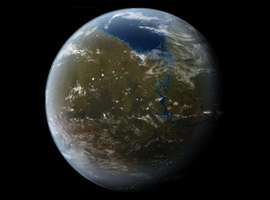The main problem for changing the appearance of Mars is the lack of a strong magnetic field that can protect the atmosphere from solar winds that burn water in it. The magnetic field creates a kind of bubble that protects the planet from the oncoming solar winds. For example, the Earth’s magnetic field prevents most high-energy particles from reaching the planet’s surface.
Ideas for generating the Martian magnetic field include either ground-based or orbital solenoids that provide some basic level of magnetic shielding. There is also the possibility of creating a ring of charged particles around Mars thanks to its satellite Phobos, reports Acta Astronautica.
Australian National University researchers have recorded 47 previously undetected seismic events beneath the Martian crust in the Cerberus Fossae region, which is less than 20 million years old. Data obtained by instruments on the InSight lander indicate that magma in the Martian mantle between the crust and core is responsible for tectonic processes. Marsquakes were detected over a period of about 350 sols, which is equivalent to about 359 days on Earth. The presence of seismic activity indicates the existence of convection of mantle rocks in the interior of Mars, which makes it difficult to explain why there is no magnetic field on the Red Planet.
In addition, in the climatic conditions of Mars, the human body will be completely defenseless against cosmic radiation, radiation, both when traveling to Mars and while on the surface of the planet. Last September, the Curiosity rover finally discovered areas on Mars with low levels of radiation safe for humans when it stopped near a steep cliff and was in the “shadow” of some cosmic radiation.
The next danger is volumetric tornadoes. In February 2021, the ESA/Roscosmos ExoMars Trace Gas Orbiter (TGO) removed giant tornadoes from orbit on Mars. In the video, bright spots moved along the bottom of a 70-kilometer crater in the southern hemisphere of Mars, leaving behind a dark streak.
Another feature of the atmosphere of Mars is that it is very rarefied, which means that sound travels slower on the Red Planet than on Earth.
Domestic scientists are already looking for a place to begin transforming the Red Planet. The overall temperature difference on Mars is approximately 160 °C, from –125 °C at the poles to +35 °C at the equator. According to the analysis of data from various devices, the most favorable temperature conditions are in equatorial latitudes. They are similar to the conditions on the coast of Antarctica. Scientists decided to consider latitudes between +30° and –30° as possible territories for initial experiments with the colonization of microorganisms and lichens, a senior researcher at the Laboratory of Nuclear Problems named after. V.P. Dzhelepova JINR Zoya Karpova.





